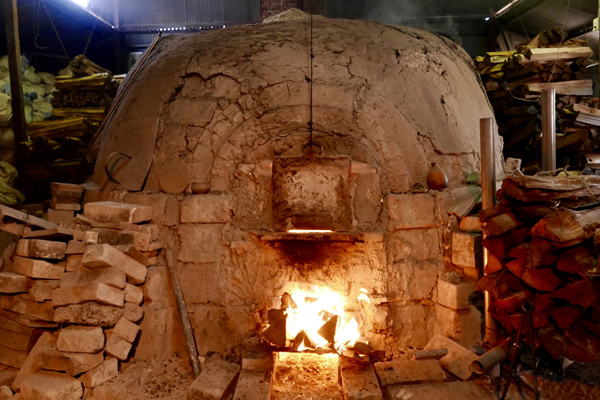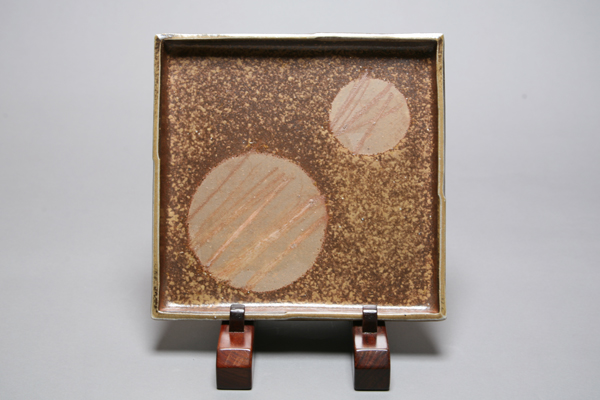The Characteristics of Bizen Pottery
Bizen Clay
It is said that there are special features to found in Bizen clays.
The clay in Bizen that Rosanji liked so much holds merit in that it was firm and pliable, meaning that it was easy to shape and difficult for water to leak through. On the other hand, it is not as strong in resisting heat and its demerit is that sometimes it is susceptible to cracking.
In the Kamakura Period, there were kilns on Mt.Kuma which suggests that the clays used there were from the mountain. It was not easy to mould the clay there since it was dry. The only good point for the kilns being in the mountains was that there was an abundance of pinewood for firing.
When it came to be sold, Bizen pottery was loaded onto ships and sent off from the harbour. As a result of this, the kilns were moved down from Mt. Kuma and were built closer to the harbour during the Kamakura period. Consequently, the clay that was used to make Bizen wares switched from mountain clay to the clay that was found in rice paddies.

The Climbing Kiln
The Bizen kilns that started with the sub-terranean anagama or cave kilns gave rise to the production of such wares as earthenware jars, storage pots and mortar bowls and became large in size. However, towards the latter half of the Edo period the industry diminished and the kilns became smaller.In the Showa Period, as a result of the pains taken by Toyo Kaneshige and others, climbing kilns emerged for special use by artists.
Depending on the location where the wares are placed in the kiln during the loading process, their effects, or ‘yaki-agari’ differs. The end-point to which the artists have used trial-and-error methods to produce the desired effects for their wares are realized in the climbing kilns that are used today.

Yohen
The additional effects found in Bizen pottery which does not use glaze are made entirely from the transformations that occur from the flames inside the kiln. These transformations are known as ‘Yohen’.The type of Bizen pottery that gains appeal from various effects or ‘expressions’ brought about by changes inside the kiln are known as ‘Yohen’ pottery.
There are various types of ‘Yohen’ and each of them have a specific name. Let us take a look at some of the representative types.
Sangiri

Sangiri’ is typical of ‘Yohen’ to the extent that when one speaks of ‘Yohen’, they usually refer to ‘Sangiri’ .
When a section of a vessel is buried by the remaining ash that is left after all the fuel is burnt up, the combination of flames being unable to make contact directly with it and the bad circulation of the air creates a matte silver effect, or ‘reduction fired’ effect. The ‘Yohen’ that is born from this is known as ‘Sangiri’.
Because Bizen pottery is fundamentally oxidized firing, the iron content of the clay changes to FeO3 and produces wares with a largely red or auburn colour. However, when the wares are buried in the ash to create a reduction state, the iron content changes to FeO2 and then further to Fe. This can be understood in the transformation of characteristic reds to a gray, black or a blueish gray colour.
In the period where wares used to be fired in communal kilns, the interior of the kilns were cross-partitioned by ‘san’ or a cross piece. The wares that were placed and fired beneath it created this ‘Yohen’, or change inside the kiln, giving rise to the name ‘Sangiri’.
When charcoal is thrown into the kiln before one stops stoking, a clear ‘Sangiri’ effect can be achieved. From this, ‘Sangiri’ is made artificially in most cases by throwing charcoal into the kiln. This method can be called ‘Sumi-Sangiri’, or ‘Charcoal Sangiri’.
Gomma (Sesame)

The ash that comes from split pine wood melts under heat and produces an ash-glaze. When it sticks to the surface of the wares it creates an appearance resembling scattered sesame seeds. This type of ‘Yohen’ is called ‘Goma’, or literally, ‘sesame-seeds’.
Hidasuki

The red streaks that are found on either white or light brown backgrounds are known as ‘Hidasuki’.Originally, in order to prevent wares getting stuck to each other, rice-straw would be placed between them or wrapped around the ware itself and placed inside larger pots or sheaths so that they can be fired without the flames making direct contact with them.
Botamochi

When small works such as sake bottles are placed on top of a dish or bowl and then fired, the area that was once covered would not change dramatically in colour and would look as if a flat white rice-cake had been placed on top of it.Presently, flat, round discs called ‘bota’ (rice-cakes) or ‘senbei’ (rice-crackers) because of their appearance, are placed on the wares and then fired.
Others
Although there are such things as Ao (blue) Bizen, Shiro (white) Bizen and Kuro (black) Bizen, there are few of these works that remain today. In recent years, the rediscovery of these techniques to create them are being researched.


 日本語
日本語










